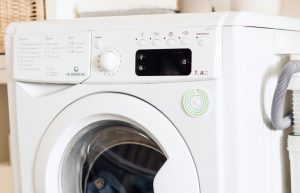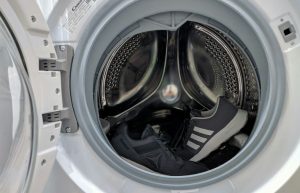Here’s a brief overview of how a washing machine works:
Drum and Tub Design:
- The inner drum is the perforated cylinder that holds the clothes during the wash cycle. It’s usually made of stainless steel or plastic.
- The outer tub surrounds the inner drum and helps contain the water and detergent solution.
- The drum is mounted on a suspension system with springs and dampers to minimize vibrations during the spin cycle.
Water and Detergent:
- Water is brought in through an inlet valve, which is controlled by the machine’s electronic control unit.
- The amount of water used is determined by sensors that measure the size of the laundry load.
- Detergent, fabric softener, and other additives are added manually by the user or automatically dispensed by the machine.
- The water and detergent are mixed together in the drum to create the washing solution.
Wash Cycle:
- The wash cycle involves periods of agitation (back-and-forth drum rotation) to physically dislodge dirt and stains.
- The agitation speed, duration, and direction can be adjusted based on the selected wash cycle.
- During the rinse cycle(s), fresh water is brought in to flush out any remaining detergent and dirt.
Spinning and Draining:
- After washing and rinsing, the machine spins the drum at high speeds (up to 1,400 RPM) to extract as much water as possible from the clothes.
- The dirty wash water is drained out of the machine through a drain hose.
- The high-speed spinning helps prepare the clothes for the next step, whether that’s drying in a clothes dryer or air drying.
Controls and Electronics:
- Modern washing machines are controlled by a microprocessor-based electronic control unit.
- This allows for precise control over the wash cycle parameters, water levels, spin speeds, and more.
- Sensors throughout the machine monitor things like water level, temperature, imbalance, and cycle progress.
How washing machine drain work
The draining process is a crucial step in the washing machine’s operation, as it removes the dirty wash water from the drum after the cleaning cycle is complete. When the wash cycle finishes, the machine’s electronic control unit activates the drain pump, which is typically located at the bottom of the outer tub. The drain pump creates suction, drawing the water out of the drum and through the drain hose, which is connected to the home’s plumbing system. The speed and duration of the drain cycle are carefully controlled to ensure that as much water as possible is removed from the laundry, preparing it for the final high-speed spin. This efficient draining process helps to reduce the amount of water left in the clothes, making the subsequent drying cycle more effective and energy-efficient. The ability to quickly and thoroughly drain the washing machine is an important design consideration that contributes to the overall performance and effectiveness of the appliance.
How washing machine motor works
At the heart of a washing machine’s operation is the electric motor, which powers the drum’s rotation during the wash and spin cycles. The motor is typically located at the base of the machine and is connected to the drum’s central shaft through a series of pulleys and belts. When the user selects a wash cycle, the machine’s electronic control unit sends an electrical signal to the motor, causing it to start rotating. The speed and direction of the motor’s rotation are carefully regulated to provide the appropriate agitation and spinning motion for the selected cycle. During the wash cycle, the motor rotates the drum back and forth, creating the necessary turbulence to effectively clean the laundry. When it’s time to spin the clothes dry, the motor accelerates the drum’s rotation to high speeds, extracting as much water as possible before the drying phase. The motor’s power and precision are essential to ensuring the washing machine’s overall performance and efficiency, allowing it to handle a wide range of fabric types and load sizes with optimal cleaning and drying results.


